#archaeological mysteries
Explore tagged Tumblr posts
Text
Us archaeologists: excavating skeletons
My senior: uh I’m so done with this
My fellow junior: I don’t want to continue
Me: sees absolutely no problem. “what’s going on?”
Them: one individual buried on his stomach with his hands between his knees somehow. The other has 7 legs stacked on top of each other. Anatomically correct. But why/how/what did you do to get 7 anatomically correct legs on top each other without other… stuff
Medieval people… for real…
#archaeology#history#indiana jones#archaeology meme#archaeology problems#field archaeologist#field archaeology#physical anthropology#osteology#archaeological mysteries
183 notes
·
View notes
Text
The Legend of the Lovelock Cave Giants: Nevada's Mysterious Past
The Legend of the Lovelock Cave Giants is a captivating tale from Nevada, blending folklore with archaeological curiosity. Situated near Lovelock, Nevada, the cave became the center of peculiar stories involving giant humanoid figures said to have once roamed the area, leaving behind a legacy wrapped in mystery and intrigue. Historical Background of Lovelock Cave Lovelock Cave, originally known…
0 notes
Text
A murder mystery film set in a medieval village. After an outbreak of plague, the villagers make the decision to shut their borders so as to protect the disease from spreading (see the real life case of the village of Eyam). As the disease decimates the population, however, some bodies start showing up that very obviously were not killed by plague.
Since nobody has been in or out since the outbreak began, the killer has to be somebody in the local community.
The village constable (who is essentially just Some Guy, because being a medieval constable was a bit like getting jury duty, if jury duty gave you the power to arrest people) struggles to investigate the crime without exposing himself to the disease, and to maintain order as the plague-stricken villagers begin to turn on each other.
The killer strikes repeatedly, seemingly taking advantage of the empty streets and forced isolation to strike without witnesses. As with any other murder mystery, the audience is given exactly the same information to solve the crime as the detective.
Except, that is, whenever another character is killed, at which point we cut to the present day where said character's remains are being carefully examined by a team of modern archaeologists and historians who are also trying to figure out why so many of the people in this plague-pit died from blunt force trauma.
The archaeologists and historians, btw, are real experts who haven't been allowed to read the script. The filmmakers just give them a model of the victim's remains, along with some artefacts, and they have to treat it like a real case and give their real opinion on how they think this person died.
We then cut back to the past, where the constable is trying to do the same thing. Unlike the archaeologists, he doesn't have the advantage of modern tech and medical knowledge to examine the body, but he does have a more complete crime scene (since certain clues obviously wouldn't survive to be dug up in the modern day) and personal knowledge from having probably known the victim.
The audience then gets a more complete picture than either group, and an insight into both the strengths and limits of modern archaeology, explaining what we can and can't learn from studying a person's remains.
At the end of the film, after the killer is revealed and the main plot is resolved, we then get to see the archaeologists get shown the actual scenes where their 'victims' were killed, so they can see how well their conclusions match up with what 'really' happened.
#film ideas#plotbunny#murder mystery#detective stories#period dramas#middle ages#history#archaeology
25K notes
·
View notes
Text
The Petelia Tablet, Greek, c.300-200 BCE: this totenpass (a "passport for the dead") was meant to be buried in a human grave; it bears an inscription that tells the dead person exactly where to go and what to say after crossing into the Greek Underworld
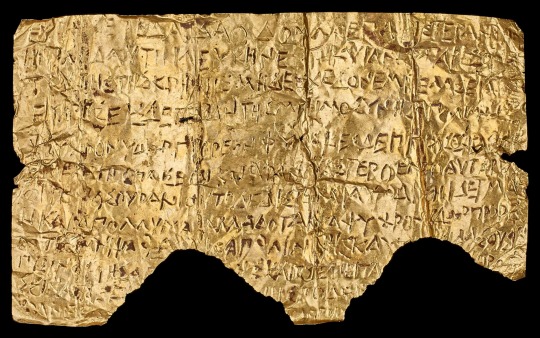
Made from a sheet of gold foil, this tablet measures just 4.5cm (a little over 1.5 inches) in length, and although it was found inside a pendant case in Petelia, Italy, it's believed to have originated in ancient Greece. It was meant to aid the dead in their journey through the Underworld -- providing them with specific instructions, conferring special privileges, and granting them access to the most coveted realms within the afterlife.
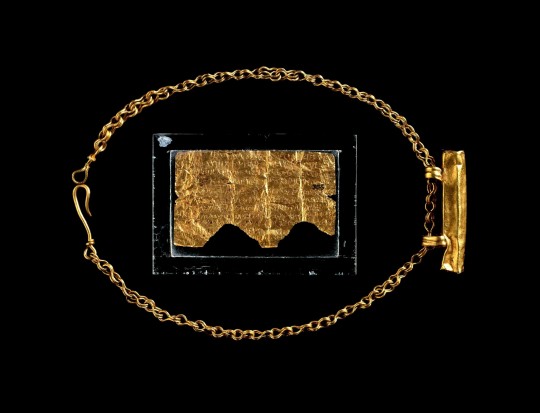
The Petelia tablet, displayed with the pendant case in which it was discovered
The tablet itself dates back to about 300-200 BCE, while the pendant case/chain that accompanies it was likely made about 400 years later, during the Roman era. It's believed that the tablet was originally buried with the dead, and that an unknown individual later removed it from the burial site and stuffed it into the pendant case. Unfortunately, in order to make it fit, they simply rolled it up and then snipped off the tip of the tablet. The final lines of the inscription were destroyed in the process.
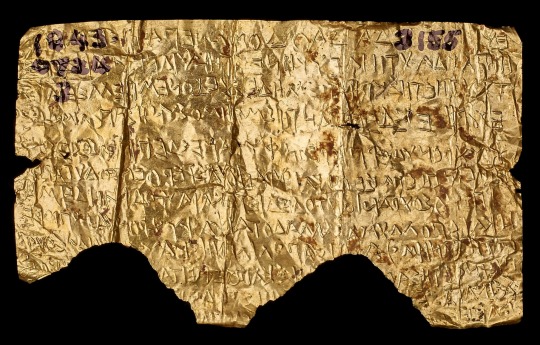
The inverse side of the Petelia tablet
These textual amulets/lamellae are often referred to as totenpässe ("passports for the dead"). They were used as roadmaps to help guide the dead through the Underworld, but they also served as indicators of the elite/divine status of certain individuals, ultimately providing them with the means to obtain an elevated position in the afterlife.
The Petelia tablet is incised with an inscription in ancient Greek, and the translated inscription reads:
You will find a spring on your left in Hades’ halls, and by it the cypress with its luminous sheen.
Do not go near this spring or drink its water. You will find another, cold water flowing from Memory’s lake; its guardians stand before it.
Say: "I am a child of Earth and starry Heaven, but descended from Heaven; you yourselves know this. I am parched with thirst and dying: quickly, give me the cool water flowing from Memory’s lake."
And they will give you water from the sacred spring, and then you will join the heroes at their rites.
This is [the ... of memory]: [on the point of death] ... write this ... the darkness folding [you] within it.
The final section was damaged when the tablet was shoved into the pendant case; sadly, that part of the inscription does not appear on any of the other totenpässe that are known to exist, so the meaning of those lines remains a mystery (no pun intended).
Lamellae that are inscribed with this motif are very rare. They're known as "Orphic lamellae" or simply "Orphic tablets." As the name suggests, these inscriptions are traditionally attributed to an Orphic-Bacchic mystery cult.
The inscriptions vary, but they generally contain similar references to a cypress tree, one spring that must be avoided, another spring known as the "Lake of Memory," the sensation of thirst, and a conversation with a guardian (or another entity within the Underworld, such as the goddess Persephone) in which the dead must present themselves as initiates or divine individuals in order to be granted permission to drink from the Lake of Memory. They are thereby able to obtain privileges that are reserved only for the elite.
Though the specifics of this reward are often vague, it may have been viewed as a way to gain access to the Elysian Fields (the ancient Greek version of paradise) or as a way to participate in sacred rites; some totenpässe suggest that it may have allowed the soul to break free from the eternal cycle of reincarnation. Regardless, the overall objective was likely the same: to obtain a special status and acquire privileges that were inaccessible to most of the souls in the Underworld.
Sources & More Info:
Altlas Obscura: The Ancient Greeks Created Golden Passports to Paradise
The Museum of Cycladic Art: The Bacchic-Orphic Underworld
Bryn Mawr College: Festivals in the Afterlife: a new reading of the Petelia tablet
The Getty Museum: Underworld (imagining the afterlife)
The British Museum: Petelia tablet (with pendant case; chain)
#archaeology#history#anthropology#ancient greece#ancient history#greek mythology#Petelia tablet#Greek mysteries#orphic mysteries#orphism#greek underworld#hades#persephone#anthropology of death#religon#afterlife#tw death#classical antiquity#classical archaeology#ticket to paradise#whoever damaged this#probably#got#a#ticket#to tartarus#instead
2K notes
·
View notes
Text


my bf bought me this old sticker as a christmas stocking stuffer and it has vexed me endlessly. aside from the fact that i haven’t put it on anything yet (it’s too good to use and i can’t decide what i want to put it on), the QR code links to a dead “this tag is no longer active” microsoft page, the URL on the front side only goes to a “getglue reloaded” facebook group, and any attempts to pull up the website on the mobile version of the wayback machine have failed. i NEED to know what secrets this sticker once contained
312 notes
·
View notes
Text

Mysterious ancient earthworks called Geoglyphs, in Rio Branco, Acre, Brazil. (Larger).
#geoglyph#geoglyphs#earthworks#ancient#ancient earthworks#ancient people#land art#agroforestry#archaeology#environment#earth science#aerial#nature#mysterious#rio branco#acre#brazil#science.org#article#articles
92 notes
·
View notes
Text
A Jianghu Mystery of the Middle Xi: The Tomb of Li Xiangyi
By Qiling, University of □□ (2024)

Left: A photograph of the inscribed text at Li Xiangyi's tomb, reading, "The grave of the Sigu Sect's departed Sect Leader, Li Xiangyi". Right: Artist's sketch renditions from eye-level frontal and aerial side views, recreating how the tomb may have appeared during the Xi dynasty.
Among the numerous important archaeological finds from the Xi Dynasty, the tomb of Li Xiangyi is not the most well-known, nor has it yielded any artifacts of particular intrigue, yet it has raised questions about certain points in history since its discovery. The tomb constitutes a small site, near a mountainous overlook which should have received little common traffic at the time of construction. Its structure is in line with some other aristocratic burials of the Middle Xi period: aboveground, with a chamber at the center of a raised rectangular dais several meters wide, large enough to bear only a single individual. A stone marker, which has survived in legible condition until today, declares it the tomb of Li Xiangyi, leader of the Sigu jianghu sect.
Records about Li Xiangyi are found at other archaeological sites contemporary with this tomb, and so his name is not an obscure one. The Sigu Sect complex has already undergone excavation for nearly two decades, with evidence that Li Xiangyi spent several years there as its first sect leader and founder. His tomb is within two hours' walking distance of the Sigu site, though isolated in its location, compared to the Sigu Sect's grand mountain entrance. (The complex itself was inhabited well after his death; bamboo slips cite Qiao Wanmian as the Sigu Sect's next major leader some years after, who oversaw it for several more decades into the later Xi). In addition, the Baichuan-Pudu site, closer to the eastern coast and historically the headquarters for the Baichuan Court, is affiliated with Li Xiangyi. Its origins apparently lay in an offshoot of the Sigu Sect, which grew into its own independent legal organization after his death.
Legends surrounding Li Xiangyi's life have been well-documented, both at Sigu and Baichuan-Pudu, but also in books and transcriptions of oral stories at sites around the country. These are dated to both the Middle and Late Xi periods, as well as a few scattered mentions in writings from the following dynasty. As a jianghu sect leader and swordsman, Li Xiangyi's reputation truly preceded him. Some tales speak of his early accomplishments, ridding towns of villainous tyrants and defeating criminals. Others talk about the founding of the Sigu Sect when Li Xiangyi was seventeen, and his subsequent missions leading his fellow swordsmen to protect the borders of the country. Not all of these narratives can be verified with surviving historical proof, and given Li Xiangyi's status in the shifting canon of folklore, the percentage that are hyperbole or fiction is likely significant. However, one that should be true, and is the most frequently told story throughout these sources, is that of Li Xiangyi's death.
All texts place Li Xiangyi as having died relatively young, with some providing a specified age, generally around twenty. He perished in a duel with Di Feisheng, leader of the Jinyuan Alliance, a rival jianghu organization and presumed threat to the Sigu Sect. As the sources say, the Jinyuan Alliance killed Li Xiangyi's sect brother, Shan Gudao, and in retaliation he used the Sigu Sect to launch a war against the Jinyuan Alliance. His final battle was the last in this war, dying in the East Sea on Di Feisheng's ship. The Jinyuan Alliance in return was badly defeated by the Sigu Sect; excavations at its first compound in the last five years have shown evidence of siege, with fire having destroyed large parts of the buildings. Afterward, the Sigu Sect disbanded without Li Xiangyi, with only the Baichuan Court continuing to function, before being resurrected one decade later.
Given this knowledge we have about Li Xiangyi, the matter of his burial should be straightforward. He had a tremendous impact on the jianghu in the few short years that he stood at its peak. He died heroically, if tragically, to obtain justice for a brother. He was honoured with a tomb, standing guard over the sect he dedicated his youth to. Why, then, is said tomb regarded as somewhat of a mystery?
This tomb was first stumbled upon during extended surveys of the Sigu site territory, with excavation taking place within the last two years. Parts of the stone chamber and foundation of the dais have withstood time, as have most things left inside. The tomb bears no signs of looting. However, there are some details which, alongside discoveries from other archaeological sites, contribute to a shadow of uncertainty on the existing narrative of Li Xiangyi's life.
Firstly, is that the austerity of the tomb does not line up with what we know of Li Xiangyi. Although overall sufficient enough for someone of his great reputation, the tomb is rather plainly embellished. There are an unexpectedly small number of burial objects inside, with those present being neither rare nor expensive. For all his contributions to the jianghu, less money and resources were poured into remembrance of Li Xiangyi than seems proper for his time.
Secondly, and far more significantly, is that the tomb holds no human remains. Whether the fact of Li Xiangyi having no recovered body to bury was made public is unknown; if it was, we do not have record of it. Certainly those who arranged for the tomb to be built and sealed would have carried this with them the rest of their lives, but no one else may be accounted for. Granted, it is not impossible for a disappeared body to have been common knowledge or presumption, as Li Xiangyi was killed at sea with no guarantee of being found. Yet this, combined with the ordinary appearance of the tomb, causes the entire site to appear... a nominal thing. Constructed to maintain acknowledgement of Li Xiangyi's absence, though his death was only marked by words, rather than a physical state.
He was given a tomb, but was Li Xiangyi truly dead before it was built?
In terms of the aforementioned other archaeological site findings, there is one that potentially implicates Li Xiangyi's death at an interesting political junction, within the context of the dynasty. The Xi Dynasty was unstable and relatively short-lived, established after taking back the Central Plains and adjacent territories from the southern conquering state of Nanyin. It endured for just under two centuries, the first of which was fraught with pockets of conflict, with many jianghu skirmishes such as that between the Sigu Sect and the Jinyuan Alliance. The greatest threat to the Xi Dynasty (until its fall) came one hundred years after its founding. Recovered archival records from the Xi capital excavation report that remaining Nanyin loyalists attempted a coup, supported by jianghu organizations, including a restored Jinyuan Alliance (although whether Di Feisheng was still its leader at this time is unclear). This attack was ultimately unsuccessful, but important to note is that the leader of this renewed Nanyin force is described as being Shan Gudao, Li Xiangyi's former sect brother.
Although Li Xiangyi brought the Sigu Sect into a war upon news of Shan Gudao's death, that demise seems to have been faked, with Shan Gudao disappearing underground only to reappear as part of a later rebellion. Could Li Xiangyi have been aware of this? Was his reaction to Shan Gudao's apparent death genuine? Or part of a coordinated plan, using him as a reason to destroy the Jinyuan Alliance, to eradicate any future resistance? Did Li Xiangyi, too, fake his death alongside Shan Gudao, in service of a shared cause? Were remnants of the Sigu Sect instructed to build an empty tomb, cementing Li Xiangyi as a dead hero so he could work in the shadows of the jianghu instead?
This is merely speculation, contradicted by the fact that if Li Xiangyi had indeed done as such, unlike Shan Gudao, after his duel with Di Feisheng he has no reappearance in any surviving records or at any archaeological site. As well, Li Xiangyi should have had no motivation for committing to such a scheme, with even loyalty to Shan Gudao a stretch for putting all the lives of the Sigu Sect on the line. That being said, history has a way of surprising the present, and this theory may not be entirely ruled out. At any rate, Shan Gudao's survival is a baffling accompaniment to Li Xiangyi's (lack of a) burial, one which will hopefully receive clarifying answers in future archaeological developments.
Perhaps the strangest piece of the puzzle concerning the end of Li Xiangyi's life, however, is Di Feisheng. After the Jinyuan Alliance was scattered by the Sigu Sect, stories regarding Li Xiangyi declared him dead and disappeared. Yet not unlike Shan Gudao, he became known in the jianghu once more about ten years later, witnessing the Nanyin's attempted coup and living long after. His tomb remained untouched, and was excavated eight years ago as part of the greater Tianji Mountain site project. The location of Di Feisheng's tomb is surprising, not only because it directly links him to the powerful and wealthy He clan of Tianji Manor, but also because he was buried next to their sole young master during the Xi Dynasty, Fang Duobing.
The son of financial minister Fang Zeshi and engineering master He Xiaohui, Fang Duobing became a notable youxia travelling the jianghu in the emperor's name, assigned in the wake of the attempted Nanyin coup. According to palace records, he was also betrothed to Princess Zhaoling, although the marriage agreement was eventually formally dissolved. What is otherwise known of Fang Duobing was his admiration of Li Xiangyi, having styled himself as a follower and disciple of him during his youth. As well, one eye-catching artifact among Fang Duobing's burial goods was a preserved wooden replica of a blade, with Li Xiangyi's name carved near the hilt. Likely a children's toy, prized and kept safe throughout Fang Duobing's life.
The exact nature of the relationship between Di Feisheng and Fang Duobing is not entirely certain, but it must have been a very close one, for Di Feisheng to have the privilege of burial on the Tianji estate. This topic justifies future study for our understanding of the Tianji He clan, already known in prior generations for its socially subversive relationships, but pertinent to Li Xiangyi is that the man whose most infamous act was to kill him, was laid to rest beside one who revered him. Why was there such a bond between these two figures, if the stories of Li Xiangyi's death have any truth to them? Did Li Xiangyi really die by Di Feisheng's blade? Did Li Xiangyi's empty tomb, plausibly signifying Di Feisheng's innocence, alter his relationship with Fang Duobing? Or indeed, did Li Xiangyi, the man himself, have a part to play in this?
No traces of him from this time remain in the archaeological record, true. But this should not be taken to mean without doubt that he was not alive then at all.
The discovery of Li Xiangyi's tomb has been an exciting development for studying this era of the Xi Dynasty, but it has also outlined doubt in areas of one man's life that were previously taken as likely facts. Li Xiangyi's tomb is scarcely fitting for his name as a founding sect leader, built more for the sake of its existence than anything else, and there was no body sealed inside to begin with. In addition, Shan Gudao— someone dear to Li Xiangyi— established a precedent of faking his death. Di Feisheng, known across the jianghu for killing the man, held a close bond with someone later in life who had personally looked up to Li Xiangyi, and so he may not have been fully responsible for Li Xiangyi's death to begin with.
What truly happened to Li Xiangyi, resulting in a tomb such as this? The past holds the answer, knowing things that we do not. Hopefully the future of archaeology will continue leading to new discoveries, and allow us to more completely understand the legend that was Li Xiangyi.
#this is probably a better archaeological research paper than the one i wrote on sanxingdui a few days ago#anyways hi yes. i just impulse wrote a fake archaeological paper for fun. enrichment. whatever#also i tried not to sound too pop culture archaeology in this#to any other anthropology or archaeology majors. if it comes off that way i am sorry </3 it's past 4am rn#mysterious lotus casebook#li xiangyi#di feisheng#fang duobing#ashton writes fic#difang#<- to any difang shippers just sit with me for a bit and think about these two being buried together
163 notes
·
View notes
Text

Olmec head.
#olmec#ancient#archaeology#magic#energy#pyramid#olmec heads#consciousness#archeology#spirit#light#ruins#ascension#mystery#engineering#esoteric
85 notes
·
View notes
Note
I want to die so badly rn
Sweetheart, I'm encouraging you to live. I cannot force you to do anything, I can only encourage. And I strongly encourage you to exist. Your life is worthy of existing. I have the honor of knowing you and your entirety.
You are always welcomed to feel and share your emotions. You are! You're given them for a reason. Emotions can be messy, that's okay as well. It's what makes you human. The important thing after feeling is the action.
This can be a suggestion; it won't hurt my feelings if the suggestion is turned down. My suggestion to you is to allow yourself to have a chance to mourn. Let the mourning process be ugly--I ugly girl cry all the time! (When it's not graduate schoolwork, of course). Allow yourself to do the Ugly Girl cry and then brush the dirt off. Once that's done, perhaps invest some time to engage in civic activity. This can be local, or state-wide, or nationwide. Make yourself heard and invest some time in building a foundation for a better future. Use this time as inspiration to create a future that you want.
The wonderful thing about being Homo Sapient-Sapiens is that we have a voice. No one can take that away from you. It took modern humans ca. 2MYA to develop the capability of speech. Now it's time to use your voice.
Let it be ugly for a day or two, then I encourage you to use your voice. And no matter what, I am proud of you for being so brave so far.
#Throwing a bit of anthropology/archaeology here because why the fuck not?#I am an anthropologist#I am an archaeologist#mystery anon#off topic
35 notes
·
View notes
Text

Baal Bal /// Baal was a Babylonian term used much like we’d say “a god” in English - not the name of ONE god in particular. This is one of the Babylonian Baals
#old book#old art#art#line art#witchy#pagan#ancient#mythology#indus valley#archaeology#etching#engraving#fine line#illustration#witch#witchy things#whimsigoth art#celestial#astrology#creepy#surrealism#whimsigoth#mystic#hermetic#alchemy#occult#esoteric#magick#mysteries#goth
60 notes
·
View notes
Text

Ancient Carved Stone, Stocks in Bowland, Tolson Memorial Museum, Huddersfield, Yorkshire
It appears to depict a human figure in a long cloak. Boulders carved with various patterns, including spirals, rings and hollows, are common on the sandstone moors of Yorkshire. They are thought to have religious significance, but their exact purpose is unknown.
#stonework#stone carving#symbols#archaeology#ancient cultures#ancient sites#ancient living#relic#mystery#landscape#ancient texts#ancient crafts#Yorkshire
24 notes
·
View notes
Text
Say your bedroom / apartment / house / workplace were suddenly perfectly preserved for future generations, a la Pompeii, King Tut's Tomb, or the Motel of the Mysteries. What would future archaeologists (from a different culture) draw from this discovery? (Wrong answers not required, but very welcome.)
75 notes
·
View notes
Text
The Curse of the Pharaohs: Unveiling Tutankhamun's Tomb
Behold the majesty of King Tut’s death mask, a stunning artifact shrouded in the mystery of the Curse of the Pharaohs. The Curse of the Pharaohs has fascinated and chilled the spines of many since the discovery of Tutankhamun’s tomb. This legendary curse is said to bring misfortune to those who disturb the resting place of an Ancient Egyptian Pharaoh. Let’s explore the mystery surrounding…
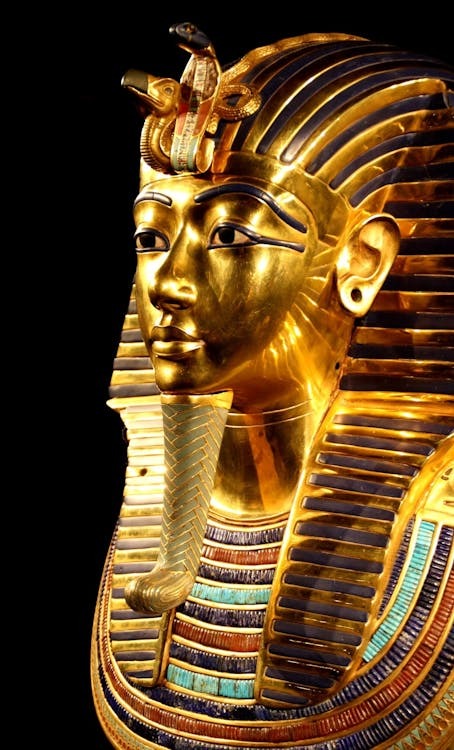
View On WordPress
#archaeological mysteries#Curse of the Pharaohs#Egyptian Pharaohs#Howard Carter#Tutankhamun&039;s tomb
0 notes
Text

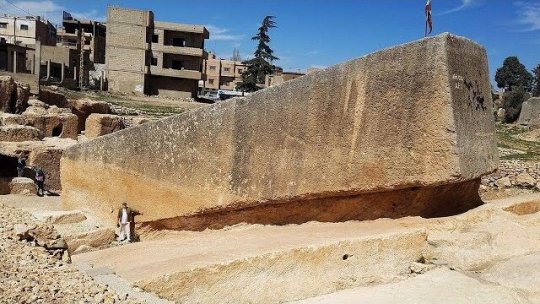


Today I found myself thinking of inexplicable boulders.
29 notes
·
View notes
Text
Well, well, well ... more evidence that Tomb II is not Philip II, but (probably) Philip Arrhidaios and Hadea Eurydikē.
Maybe it's time to dust off my "Who's Buried in Philip's Tomb?" public lecture. Anybody at a department with money to bring in a guest lecturer and Macedonian specialist? :-)
#Royal Tomb II at Vergina#Macedonian Royal Tombs#Alexander the Great#ancient Macedonia#the mystery of the Macedonian royal tombs#Philip II of Macedon#Philip of Macedon#Philip III Arrhidaios#Classics#Greek archaeology
23 notes
·
View notes
Text





Sean bienvenidos japonistasarqueologos a una nueva entrega, en esta ocasión nos vamos al fondo marino para ver unas de las mayores ruinas arqueológicas que están generando en la comunidad científica muchas controversias desde que fueron descubiertas en 1985. Dicha estructura se encuentra en Okinawa la cual está compuesta por las islas Ryukyu. - Las ruinas tienen unos 10.000 años de antigüedad ¿Hay dos teorías?La primera que dicen los científicos es: que es natural.La segunda es que es artificial.Yo he visto, todo el material registrado hasta el momento en fotos y vídeos para ser sinceros no me parece para nada natural hay puntos en lo que claramente que están trabajados por la mano del hombre. Sí nos imaginamos el montículo fuera de la superficie lo más probable es que se pareciera en su forma natural a una elevación en el terreno y lo más probable es que estuviera en su estado más virgen.-También hay que destacar que el nivel del mal sobre esas fechas era 120 veces más bajo que el actual, por lo que no sería raro que los moradores lo usaran como un lugar sagrado. Ya que para los japoneses el trabajo en roca no es nada nuevo y sobre todo construcciones colosales hechas en piedra como veremos en próximas publicaciones. - Espero que os haya gustado y espero vuestras opiniones y debates sobre el tema que nunca nos va a dejar de sorprender os deseo un feliz dia y una buena semana. - 日本の考古学者は新作を歓迎します。今回は海底に行き、1985年に発見されて以来、科学界で多くの論争を引き起こしている最大の考古学的遺跡の1つを見に行きます。琉球諸島。-遺跡は約1万年前のものですが、2つの説がありますか?科学者が最初に言うことは、それは自然なことだということです。二つ目は、それが人工的であるということです。これまでに写真やビデオに記録されたすべての資料は、正直なところ、私にはまったく自然に見えません。それらが人間の手によって明確に処理されている点があります。地表の外側のマウンドを想像すると、それは自然な形で地面の隆起に似ている可能性が高く、最も手付かずの状態である可能性が最も高いです。-また、当時の悪のレベルは現在の120分の1であったため、住民が聖地として利用することも珍しくありません。日本のロック作品は目新しいものではなく、特に将来の出版物で見られるように石で作られた巨大な構造です。-皆様のご愛顧を賜りますよう、よろしくお願い申し上げます。今後とも変わらぬご意見・ご感想をお待ちしております。 - Welcome japonistaarqueologos to a new installment, this time we go to the seabed to see one of the largest archaeological ruins that are generating many controversies in the scientific community since they were discovered in 1985. This structure is located in Okinawa, which is made up of the Ryukyu Islands. - The ruins are about 10,000 years old. Are there two theories? The first one that scientists say is: that it is natural. The second is that it is artificial. I have seen all the material recorded so far in photos and videos, to be honest, it does not seem natural at all to me. There are points that are clearly worked by the hand of man. If we imagine the mound off the surface, it most likely resembled in its natural form a rise in the ground and most likely it was in its most virgin state. - It should also be noted that the level of evil at that time was 120 times lower than today, so it would not be unusual for the inhabitants to use it as a sacred place. Since for the Japanese, rock work is nothing new and especially colossal constructions made of stone as we will see in future publications. - I hope you liked it and I look forward to your opinions and debates on the subject that will never cease to surprise us. I wish you a happy day and a good week.
#日本#アート#写真#考古学#沖縄#与那国島#ミステリー#海#ユネスコ#歴史#japan#art#photography#archaeology#okinawa#Yonaguni#mystery#sea#history#unesco#geography#artists on tumblr
26 notes
·
View notes